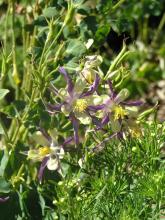
High Plains Gardening
The gardening website of the Texas High Plains Region

Many Aquilegia’s are native to the U.S. Golden columbine, Aquilegia chrysantha is a Texas and southwest native, has yellow flowers and can take more sun than some varieties. McKana's Giant is the hybrid columbine most often sold. Large beautiful bi-colored flowers dazzle in woodland and shady area. Rocky Mountain columbine, Aquelegia caerulea; and wild columbine, A. canadensis, are other common columbines. Rocky Mountain columbine is the state flower of Colorado.
Generally avoid placing them in afternoon sun. Some references note that acidic soil is needed, however they grow beautifully in the Texas Panhandle in soil amended with compost.
Beautiful blue green lacy foliage with fine stems that dies back in the summer. Dainty flowers with spurs; an earlier common name was granny’s bonnet. Will reseed some. When species are mixed together, I've noticed most seedlings are commonly yellow. Terrific flower for the woodland border area. Many varieties and colors are available.
For more information on A. chrysantha, golden columbine, click here.
Columbines work well in mixed borders and beds, Western cottage gardens, and shade gardens. The foliage in early spring provides a pleasing backdrop for daffodils, tulips and other spring blooming bulbs. As the plant dies back after flowering in late June, it's ideal for planted next to summer flowering beauties.
Iris, ornamental alliums and poppies make great companion plants in a spring mixed border. Columbines also combine well behind coral bells and cranebills in a dry shade border.
Columbines can be transplanted into containers and grown with other spring blooming flowers.
Cut back the dead and dying foliage and stems in June. Mature plants will rebloom some over the summer with additional moisture. Compost the bed each fall or spring.